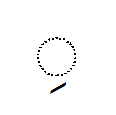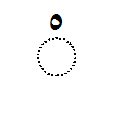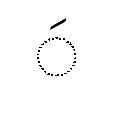Harakat
Harakat (حركات) albo taszkil (تشكيل) – system wokalizacji spółgłosek arabskiego alfabetu przy pomocy dodatkowych znaków diakrytycznych. System ten jest jednak używany prawie wyłącznie w Koranie i w podręcznikach.
Znaki diakrytyczne harakatu to
Fatha i fathatan
 Fatha jest znakiem opcjonalnym oddającą głoskę „a”. Z następującym po niej alifem długie „a”.
Fatha jest znakiem opcjonalnym oddającą głoskę „a”. Z następującym po niej alifem długie „a”. Fathatan jest znakiem opcjonalnym stosowanym w niektórych przypadkach biernika w celu oddania końcówki „-an”.
Fathatan jest znakiem opcjonalnym stosowanym w niektórych przypadkach biernika w celu oddania końcówki „-an”.
Kasra i kasratan
 Kasra jest znakiem opcjonalnym oddającą głoskę „i”. Z następującym po niej ي (yāʾ) długie „i”.
Kasra jest znakiem opcjonalnym oddającą głoskę „i”. Z następującym po niej ي (yāʾ) długie „i”. Kasratan jest znakiem opcjonalnym stosowanym w niektórych przypadkach celownika w celu oddania końcówki „-in”.
Kasratan jest znakiem opcjonalnym stosowanym w niektórych przypadkach celownika w celu oddania końcówki „-in”.
Damma i dammatan
 Damma jest znakiem opcjonalnym oddającą głoskę „u”. Z następującym po niej و (wāw) długie „u”.
Damma jest znakiem opcjonalnym oddającą głoskę „u”. Z następującym po niej و (wāw) długie „u”. Dammatan jest znakiem opcjonalnym stosowanym w niektórych przypadkach mianownika w celu oddania końcówki „-un”.
Dammatan jest znakiem opcjonalnym stosowanym w niektórych przypadkach mianownika w celu oddania końcówki „-un”.
Sukun
 Sukun, w odróżnieniu od wyżej opisanych, ma jako cel wskazanie, że po spółgłosce nad którą stoi nie następuje samogłoska.
Sukun, w odróżnieniu od wyżej opisanych, ma jako cel wskazanie, że po spółgłosce nad którą stoi nie następuje samogłoska.
Szadda lub taszdid
 Szadda ma za zadanie wskazania, iż spółgłoska nad którą stoi wymawiana jest podwójnie (jak np. „d” w wyrazie „szadda”).
Szadda ma za zadanie wskazania, iż spółgłoska nad którą stoi wymawiana jest podwójnie (jak np. „d” w wyrazie „szadda”).
Wasla
 Wasla jest znakiem stojącym niekiedy nad alifem na początku wyrazów. Oznacza, iż samogłoska na początku wyrazu (z wyjątkiem w absolutnym nagłosie lub na początku zdania) nie jest wymawiana.
Wasla jest znakiem stojącym niekiedy nad alifem na początku wyrazów. Oznacza, iż samogłoska na początku wyrazu (z wyjątkiem w absolutnym nagłosie lub na początku zdania) nie jest wymawiana.
Unikody
- fatha: U+064E
- fathatan: U+064B
- kasra: U+0650
- kasratan: U+064D
- damma: U+064F
- dammatan: U+064C
- sukun: U+0652
- szadda: U+0651
- alif wasla: U+0671
Media użyte na tej stronie
"Arabic" in written Arabic (Naskh script)
Autor: Benutzer:Korny78, Licencja: CC-BY-SA-3.0
Das arabische Schriftzeichen Wasla auf dem Buchstaben Alif.
(c) Korny78, CC-BY-SA-3.0
The letter Damma from the Arabic alphabet, belonging to the group of Harakat diacritic marks, used to represent vowels. Damma sounds like a short /u/. The circle indicates the position of the consonant the Harakat is used upon.
(c) Korny78, CC-BY-SA-3.0
The letter Kasra from the Arabic alphabet, belonging to the group of Harakat diacritic marks, used to represent vowels. Kasra sounds like a short /i/. The circle indicates the position of the consonant the Harakat is used upon.
(c) Korny78, CC-BY-SA-3.0
The letter Sukun from the Arabic alphabet, belonging to the group of Harakat diacritic marks, used to represent vowels. Sukkun is used to indicate the absence of a vowel. The circle indicates the position of the consonant the Harakat is used upon.
(c) Korny78, CC-BY-SA-3.0
The letter Fatha from the Arabic alphabet, belonging to the group of Harakat diacritic marks, used to represent vowels. Fatha sounds like a short /a/. The circle indicates the position of the consonant the Harakat is used upon.
The letter Shadda from the Arabic alphabet, belonging to the group of Harakat diacritic marks, used to represent vowels. The shadda marks a long consonant. It is thus functionally equivalent to writing a consonant twice in most Latin writings. The circle indicates the position of the consonant the Harakat is used upon.
(c) Korny78, CC-BY-SA-3.0
The letter Kasratan from the Arabic alphabet, belonging to the group of Harakat diacritic marks, used to represent vowels. The Kasratan (actually two Kasras) is found at the end of words in the undetermined genitive case and sounds like /in/. The circle indicates the position of the consonant the Harakat is used upon.
(c) Korny78, CC-BY-SA-3.0
The letter Dammatan from the Arabic alphabet, belonging to the group of Harakat diacritic marks, used to represent vowels. The Dammatan (actually two Dammas) is found at the end of words in the undetermined nominative case and sounds like /un/. The circle indicates the position of the consonant the Harakat is used upon.
(c) Korny78, CC-BY-SA-3.0
The letter Fathatan from the Arabic alphabet, belonging to the group of Harakat diacritic marks, used to represent vowels. The Fathatan (actually two Fathas) is found at the end of words in the undetermined accusative case and sounds like /an/. The circle indicates the position of the consonant the Harakat is used upon.









